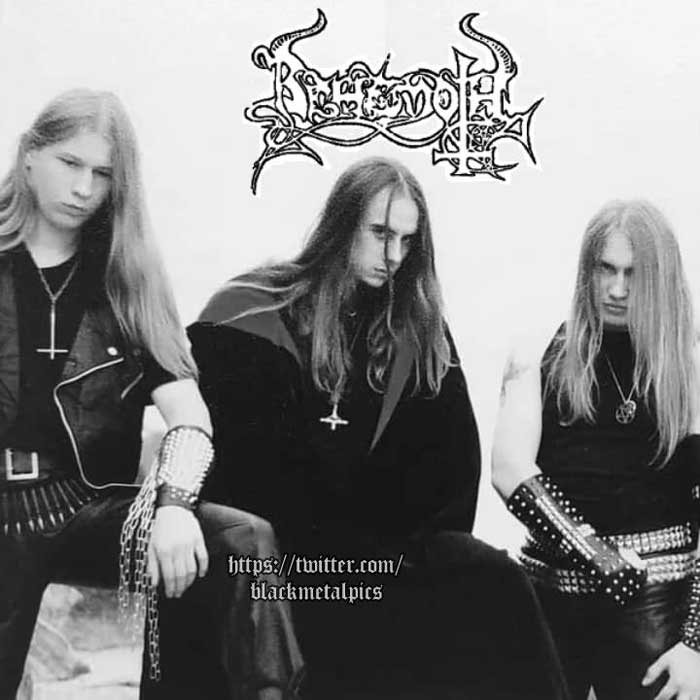Black Metal History – Origins, Influences, and the Path of Darkness

Introduction: Embracing the Abyss
Black metal, with its raw, uncompromising sound and unapologetic attitude has carved a unique place in the realm of heavy metal. This extreme sub-genre emerged from the underground music scene, gaining notoriety for its piercing vocals, heavily distorted guitars, and blistering drumming. In this in-depth exploration of black metal history, we embark on a journey through the origins, influences, and dark path it has traversed, revealing the captivating allure of the genre’s unyielding spirit.
Shrouded Beginnings: Forging the Path of Darkness
Black metal‘s roots can be traced back to its origins in death metal, as musicians sought to forge a distinct identity. Rejecting the perceived commercialization of death metal, these artists embraced a new vision characterized by light screaming vocals and a more sinister atmosphere. Thus, the seeds of black metal were sown, and early bands like Venom and Bathory emerged as catalysts of this dark revolution, infusing their thrash metal sound with elements of darkness and transforming the genre forever.
Venom, Black Metal (1982)

Black Metal album, released in 1982 by the iconic English band Venom, stands as a groundbreaking album that played a pivotal role in shaping the genre itself. Venom’s sinister and raw sound, coupled with their unapologetic embrace of darkness and rebellion, laid the foundation for the black metal movement to come. The album’s title track, “Black Metal,” became an anthem for the genre, defining its aesthetic and sonic characteristics. Venom‘s aggressive guitar riffs, rapid-fire drumming, and the menacing snarls of vocalist Cronos (Conrad Lant) created an atmosphere of primal energy and unleashed a torrent of darkness upon the world. With Black Metal, Venom not only solidified their place as one of the pioneers of the genre but also left an indelible mark on the entire black metal landscape.

Bathory, Bathory (1984)
Bathory, the brainchild of Swedish musician Quorthon, made a significant impact on the early development of black metal with their self-titled debut album, released in 1984. This groundbreaking release laid the groundwork for the dark and atmospheric sound that would become synonymous with the genre. Bathory’s raw and primitive approach, characterized by distorted guitars, relentless drumming, and Quorthon’s haunting vocals, evoked a sense of ancient evil and occult mysticism. The album’s raw production quality only added to its eerie and chilling atmosphere, capturing the essence of black metal’s aesthetic. Bathory’s self-titled album not only served as a precursor to the Scandinavian black metal scene but also inspired countless bands to delve into the realms of darkness and create their own blackened sonic landscapes.

Mayhem, Deathcrush (1987)
Mayhem, formed in 1984, is widely regarded as one of the most important and influential bands in the black metal history. With their raw and uncompromising sound, Mayhem played a crucial role in shaping the genre and pushing its boundaries. Their early releases, including the infamous “Deathcrush” EP and the unfinished masterpiece “De Mysteriis Dom Sathanas,” showcased their dark and extreme musical vision. Mayhem’s notoriety extended beyond their music, as they became synonymous with the controversial and sometimes violent aspects of black metal. Tragic events, such as the suicides of vocalist Per Yngve Ohlin and the murder of guitarist Euronymous, further solidified their reputation and added a haunting mystique to their legacy. Despite the tumultuous history, Mayhem’s impact on black metal is undeniable, and their uncompromising approach to music and aesthetics continues to inspire countless bands in the genre.

Rise of the Norwegian Titans: Igniting the Black Metal Flame
While the early black metal bands of the 80s laid the groundwork, it was the Norwegian bands that truly propelled the genre forward, igniting a flame that would engulf the world. Mayhem, the first Norwegian black metal band, released their groundbreaking EP “Deathcrush” in 1987, captivating the small but growing black metal community. Alongside Mayhem, bands like Immortal, Darkthrone, Burzum, and Emperor rose to prominence, each leaving an indelible mark on the genre. As the 90s unfolded, some bands embraced satanic themes, while others delved into Norse mythology, further enriching the tapestry of black metal.

Peering into the Abyss: Unveiling Black Metal's Darker Side
The black metal scene took a darker turn, captivating the world with its extreme behavior and controversial actions. Notorious incidents, such as the tragic suicide of Mayhem’s vocalist Per Yngve “Pelle” Ohlin and the church burnings carried out by some members of the community, garnered international attention. Varg Vikernes, a key figure in the movement, made headlines with his involvement in the burnings and the murder of Mayhem’s guitarist Euronymous. Despite the controversies, black metal had become a potent force, captivating audiences with its unapologetic darkness.

The Dawn of the Black Hearts is a bootleg live album by the Norwegian black metal band Mayhem, infamous for its controversial cover art and the tragic circumstances surrounding it. The album features a photograph of Mayhem’s vocalist Per “Dead” Ohlin shortly after his suicide in 1991. Taken by guitarist Euronymous, who discovered the body, the photograph became the album’s cover image. Despite its status as a bootleg, “The Dawn of the Black Hearts” has gained notoriety and is considered one of the most bootlegged black metal releases of all time. This event, while controversial, stands as a haunting reminder of the extreme and controversial nature of black metal and its impact on both the music and the culture surrounding it.

Titans of Black Metal: Pioneers Who Shaped the Darkness
Euronymous (Mayhem)
Euronymous, born Øystein Aarseth, is an iconic figure in black metal history. As the guitarist and founder of the band Mayhem, he played a central role in shaping the early development of the genre. Euronymous not only pushed the boundaries of black metal with his aggressive and raw guitar playing but also established the infamous record label Deathlike Silence Productions, which became a platform for releasing some of the most groundbreaking black metal albums of the time. With his band’s chaotic live performances and controversial image, Euronymous embodied the extreme and confrontational spirit of black metal, leaving an indelible mark on the genre.
Deathlike Silence Productions was a record label founded by Euronymous, the guitarist of Mayhem, in Oslo in 1987 with the name “Posercorpse Music“. The label played a crucial role in shaping the black metal scene and promoting the genre’s early pioneers. Euronymous sought to create a platform for extreme and underground black metal bands, releasing albums that captured the raw, uncompromising essence of the genre. One of the label’s most notable releases was Mayhem’s iconic debut album, “De Mysteriis Dom Sathanas.” Unfortunately, the label’s existence was cut short by tragic circumstances when Euronymous was murdered in 1993. Despite its short lifespan, Deathlike Silence Productions left a lasting impact on the black metal community, and its releases continue to be revered as cult classics.

Varg Vikernes (Burzum)
Varg Vikernes, also known as Count Grishnackh, is a highly influential and controversial figure in black metal. As the sole member of Burzum, Vikernes created a unique and atmospheric sound that incorporated elements of black metal, dark ambient, and Nordic mythology. However, his notoriety extends beyond his music. Vikernes became infamous for his involvement in church burnings that shocked the world and for the murder of Euronymous, which marked a tragic turning point in black metal’s history. Despite his controversial actions, Vikernes’ music and ideas continue to resonate within the black metal community, making him a significant figure in the genre’s evolution.

Quorthon (Bathory)
Quorthon, born Thomas Börje Forsberg, is widely regarded as one of the pioneers of black metal. As the mastermind behind the band Bathory, he played a crucial role in shaping the genre’s early sound and aesthetic. Quorthon’s musical vision merged elements of black metal, thrash metal, and Viking mythology, resulting in albums that were raw, aggressive, and epic in their scope. With albums like “Under the Sign of the Black Mark” and “Blood Fire Death,” Quorthon laid the foundation for the atmospheric and epic aspects that would become hallmarks of black metal. His influential songwriting and distinctive vocal style continue to inspire countless black metal bands, cementing his legacy as a true icon of the genre.

The Infamous Church Burnings: Unleashing the Flames of Controversy
In the early 1990s, Norway became the epicenter of a series of church burnings that sent shockwaves through the black metal community and the world at large. These acts of arson, carried out by members of the Norwegian black metal scene, were seen as a radical and extreme expression of rebellion against societal norms and organized religion. The churches, considered symbols of Christianity and authority, became targets of destruction as a means to manifest the nihilistic and anti-establishment ideology that black metal embraced.
It was claimed that notorious figures such as Varg Vikernes, Euronymous, and other members of Mayhem were involved in these acts, perpetuating a wave of darkness and controversy that would forever be associated with the black metal movement. The church burnings garnered international media attention, painting black metal as a genre intertwined with violence and extremism.
The impact of these church burnings on the black metal genre cannot be understated. While some argue that it was a manifestation of extreme ideologies taken to the extreme, others saw it as an artistic expression of rebellion against societal constraints. The church burnings, along with other notorious events and actions, further cemented the association between black metal and controversy, solidifying its image as an extreme and dangerous subculture.
In the aftermath of these events, the Norwegian black metal scene faced heightened scrutiny and legal consequences. Varg Vikernes, in particular, was convicted for his involvement in the church burnings and the murder of Euronymous, resulting in a lengthy prison sentence. The controversy surrounding the church burnings created a divide within the black metal community, with some condemning the actions as senseless acts of violence, while others celebrated them as a necessary rebellion against societal norms.
Despite the dark legacy of the church burnings, they became a defining moment in the black metal history, leaving an indelible mark on the genre’s narrative. The controversy surrounding these events and the ensuing media attention propelled black metal into the public consciousness, granting it a notoriety that further fueled its allure and fascination.
While the church burnings remain a controversial chapter in black metal’s history, they symbolize the extreme and rebellious spirit that defined the genre during its formative years. They serve as a reminder of the boundary-pushing nature of black metal, as well as the complex relationship between art, ideology, and societal norms. The impact of these events continues to shape the perception and understanding of black metal as a genre that defies conventions and embraces the darkness.

The Enigmatic Cover of Aske: A Symbolic Glimpse into Burzum's World
The cover of the Aske EP by Burzum, released on 10 March 1993, remains an enigmatic and iconic image within the black metal realm. The photograph, taken from a southwestern angle beneath the plinth the building was re-erected on in 1883, captures a haunting and desolate scene. It serves as a symbolic glimpse into the world of Burzum, the solo project of Varg Vikernes.
The image on the cover resonates with the atmospheric and introspective nature of Burzum’s music. It evokes a sense of isolation and desolation, mirroring the themes and aesthetics that Vikernes sought to convey through his compositions. The choice of perspective, from beneath the plinth, adds an element of mystery and subversion, inviting the listener to explore the hidden depths within the music.
Aske, meaning “ashes” in Norwegian, is a fitting title for the EP and further contributes to the evocative imagery of the cover. It hints at themes of destruction, rebirth, and the transformative power of fire. The burning church depicted on the cover becomes a symbolic representation of the rebellious and iconoclastic spirit that permeates Burzum’s music and the black metal genre as a whole.

Into the Abyss: Black Metal's Journey of Exploration and Evolution
Over time, black metal evolved, branching into sub-genres and blending with other styles. Crossover genres like blackened death metal and symphonic black metal emerged, pushing the boundaries of the genre. Bands such as Behemoth, Necrophobic, and Belphegor infused black metal with elements of death metal, creating a more aggressive and brutal sound. This constant exploration and experimentation have kept black metal relevant and allowed it to retain its allure. From the depths of darkness, black metal continues to evolve, embracing new influences and expanding its horizons.

Unmasking the Shadows: Demystifying Myths and Embracing Realities
Black metal is often misunderstood, plagued by misconceptions of satanic worship and violence. While the genre can indeed delve into darker themes, it is not solely defined by them. Black metal’s lyrical landscape is vast and diverse, with bands expressing a wide range of ideas and concepts. From Morbid Angel‘s anti-Christian messages to the evocative and sinister lyrics of Obituary, black metal bands captivate listeners with their unique approach to exploring darkness and existential themes. The genre’s multifaceted nature defies simple categorization, inviting individuals to delve into its complex sonic realm and discover the intricacies of its artistic expression.
Paths Less Traveled: Diverse Explorations within the Black Metal Realm
As black metal continued to evolve, other sub-genres sprouted, each offering its own unique blend of influences. Death-doom, symphonic black metal, and technical melodic black metal pushed the genre’s boundaries, fostering innovation and creativity. Opeth, known for their fusion of progressive rock, jazz, death metal, and Scandinavian folk with the aggression of black metal, exemplify this diversity and demonstrate how the genre can be reinvented while retaining its dark essence. These diverse paths invite listeners to embark on a sonic journey through uncharted territories, where darkness takes on new and unexpected forms.

Flames of Resilience: The Unyielding Spirit of Black Metal
Black metal has weathered the storms of controversy and emerged stronger than ever. Bands like Gorgoroth, Satyricon, Dimmu Borgir, Mayhem, Emperor, Enslaved, Immortal, and many more continue to release music and tour, carrying the torch of black metal into the future. The genre’s fanbase has expanded globally, transcending nations and cultures. What began as a small, rebellious movement has grown into a solid community united by a shared love for the dark and atmospheric realm of black metal. The flames of resilience burn bright, fueling the passion and unwavering spirit that define black metal.

Embracing the Darkness
Black metal’s allure lies in its ability to transport listeners to a world of cold winters and dark forests, where emotions are heightened and the atmosphere is thick with intensity. It continues to captivate audiences, invoking a range of feelings from anger and sorrow to transcendence and empowerment. The genre’s enduring spirit thrives not only in its musical output but also in its loyal community, which remains passionate and open-minded. Within the embrace of darkness, black metal creates an immersive experience, an escape into a realm where the shadows reveal their secrets.
In conclusion, black metal history is a tale of darkness, rebellion, and musical evolution. From its humble beginnings to its present-day incarnations, black metal has left an indelible mark on the world of heavy metal. It is a genre that thrives on its ability to provoke, challenge, and captivate its listeners. We hope this in-depth journey through black metal history has shed light on its origins, influences, and the enduring spirit that continues to fuel its dark flame, inviting you to explore the depths of its sonic realm. Thank you for reading.



